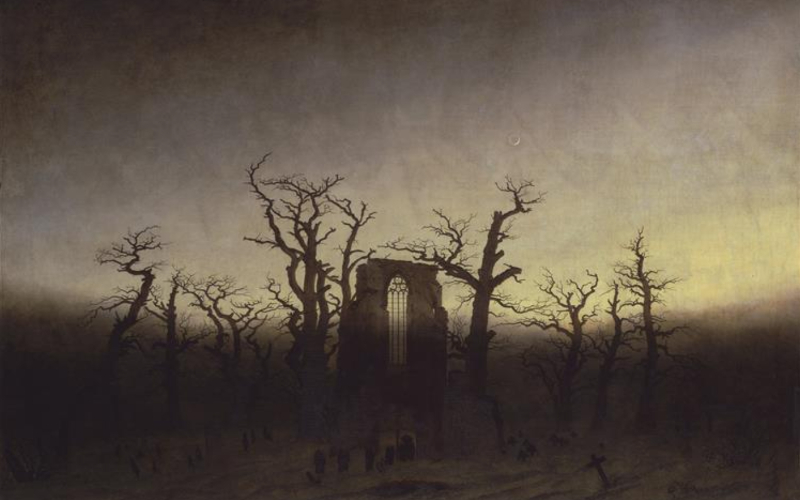Caspar David Friedrich painted The Abbey in the Oakwood, known in German as Abtei im Eichwald. It was created in Dresden between 1809 and 1810 and debuted alongside The Monk by the Sea at the Prussian Academy of Arts exhibition in 1810.
The Abbey in the Oakwood was hung below The Monk by the Sea at Friedrich’s request. Over two dozen of Friedrich’s paintings feature cemeteries or graves, including this one.
King Frederick Wilhelm III purchased both paintings for his collection following the exhibition. These days, the paintings are displayed side by side in Berlin’s Alte Nationalgalerie.
In the center of the painting, a procession of monks, some carrying coffins, walks toward the gate of a ruined Gothic church. Only two candles illuminate their path.
A freshly dug grave yawns from the snow in the foreground, near which several crosses can be seen. Only the highest part of the ruins and the tips of the leafless oaks are lit by the setting sun in the lower third of the image. In the sky, a waxing crescent moon appears.
The painting was released at a time when Friedrich had achieved his first public success and critical acclaim with the contentious Tetschener Altar. Although Friedrich’s paintings are landscapes, he created them in his studio using freely drawn plein air sketches from which he selected the most evocative elements to incorporate into an expressive composition.
The Abbey in the Oakwood is based on studies of Eldena Abbey’s ruins, which appear in several other paintings. The same trees, in slightly different forms, can also be seen in other works.
Eldena Abbey may have had personal significance for Friedrich because it was destroyed during the Thirty Years War by invading Swedish troops, who later used the abbey’s bricks to build fortifications.
Friedrich compares these actions in the painting to the occupation French soldiers‘ use of Greifswald churches as barracks. As a result, the funeral represents “the burial of Germany’s hopes for resurrection.”
After visiting Rügen, Neubrandenburg, Friedrich may have started work on The Abbey in the Oakwood in June 1809. Just before the Berlin Academy exhibition, on September 24, 1810, Carl Frederick Frommann gave a description of the half-moon and setting sun in the almost-completed painting.


